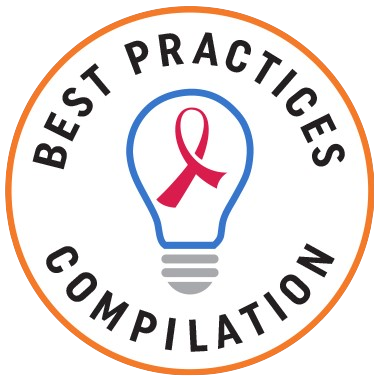In 2017, Allegheny Health Network, an urban clinic in southwestern Pennsylvania, implemented Patient-Centered Appointment Reminders over a five-month period to improve engagement in care for people with HIV. This intervention included text message reminders, a process for identifying and addressing barriers to care, home visits, and outreach to patients after missed appointments. Compared to the pre-intervention cohort, the post-intervention group showed a significant decrease in clinic no-show rates.
PA
The intervention was conducted at a clinic in southwestern Pennsylvania that serves patients from 10 counties. While most patients had an antiretroviral therapy (ART) prescription and were virally suppressed, rates of engagement in care were surprisingly low. In 2016, only 69% of patients were retained in care in a two-year time frame.1 Clinic no-show rates ranged between 30% and 35%. Retention in care and ART adherence are crucial in maintaining viral suppression; patients who miss follow-up appointments are at a significantly greater risk for health complications. The intervention focused on patients who often face barriers to care, including patients who did not have health care coverage, had a mental health diagnosis, were living at or below the federal poverty level, or had a substance use disorder.
“Patients who routinely missed appointments tended to be non-adherent to ART, experienced unsuppressed viremia, and had increased ART resistance and transmission rates of HIV infection in the community.”
Prior to intervention implementation, patients could receive their appointment reminders via email, text messages, or phone call. During intake at the clinic, staff documented patient preference in the electronic health record (EHR). Reminders were sent to patients in whatever mode they preferred two weeks before an appointment and again within 48 hours of the appointment.
The Woodward Risk Prediction Tool served as a basis for patients to receive more intensive services, such as case manager calls and home visits, as described below. This tool scores patients on a scale from 1–8, with 2–3 considered medium risk for missing appointments and 4–8 considered high risk. These scores were calculated using the following information: attendance at the last scheduled appointment, CD4 count and viral load, adherence to medication, and substance use.
Case managers completed a pre-visit planning call with patients considered medium risk. Two weeks prior to the appointment date, case managers reviewed patient history to assess any barriers that needed to be addressed, like transportation. Case managers offered incentives to attend appointments, including food vouchers and gift cards. If patients did not answer the initial phone call, case managers followed up via email or text.
Peer navigators conducted home visits with patients who scored as high-risk for missing appointments. Peer navigators were people with HIV with clinic experience, and motivational interviewing and peer support training. During the home visits, the navigator used a questionnaire to determine why patients were missing appointments. Patients were offered same-day appointments and transportation options if needed.
Every day, the clinic generated a list of patients who had missed an appointment that day. This list was distributed to clinic staff, including a physician assistant, the administrative director, and a medical assistant, for follow-up phone calls. Staff were required to contact patients within 24 hours of their missed appointments. Messaging was standardized to ensure appropriate care.
Monthly no-show rates were calculated by dividing the total number of missed appointments by the total number of scheduled appointments within the month. The five-month project period no-show rate was compared to the no-show rate of the same five-month period from the previous year.
| Category | Information |
|---|---|
| Evaluation data | Scheduling and appointment data captured in clinic EHR |
| Measures | Five-month no-show rate during the intervention period compared to the rate from the previous year |
| Results | There was a 3.8% decrease in the no-show rate in the post-intervention cohort compared to the pre-intervention cohort (30.3% vs. 26.5%, p = 0.023).* * statistically significant |
Source: Adams J. A., Whiteman K., McGraw S. Reducing missed appointments for clients with HIV: An evidence-based approach. J Nurs Care Qual. 2020; 35(2), 165–170.
“While the goal of this project was to increase appointment adherence to improve HIV care, an unintentional consequence was increased communication between members of the care team about the nuances of individual client behavior related to keeping appointments.”
Multidisciplinary planning team. An interprofessional team—an administrative director, clinical pharmacist, data manager, fiscal officer, chief physician assistant, peer-patient navigator, case manager, and clinical associate—made recommendations on how to sustain patient engagement and decrease no-show rates at the clinic. This team met once a week over the five-month period to plan project implementation and identify best practices.
Intervention framework. The team used the Johns Hopkins Nursing Evidence-Based Practice Model as the theoretical basis.
- It is important to make sure the care team staffing model includes adequate time for case managers to call all patients at medium risk for missing appointments.
- The initial Woodward Risk Prediction Tool methodology was modified because it did not sufficiently identify patients at risk for missing appointments. This updated methodology took into consideration whether a patient missed at least three appointments in the previous six months.
- The follow-up call within 24 hours after a missed appointment was a costly aspect of the intervention, and did not necessarily improve appointment attendance because patients had not addressed the crisis or issue that made them miss the appointment in the first place.
- Many members of the care team have established long-term relationships with patients. This therapeutic bond enabled staff to reach out more effectively to reengage patients into care.

